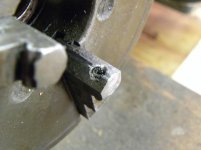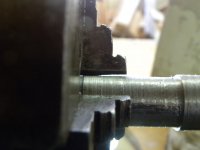The previous owner of my lathe somehow managed to mess up a jaw on the three jaw chuck.

I was thinking about building a tool post grinder when I found one at a tool swap.
So I ground the jaws with a internal 1" course grinding wheel and then a fine 3/8" internal wheel.
I "thought" the jaws looked really nice. I actually only ground down about .005" the hole was another 015".
And then I tested the grind.

The jaws are making contact only on the rear.

So how would I align the grinder?
I can see where just eyeballing it probable would work for external grinds but not for internal grinds.
I would like to be able to do straight and taper internal grinds but cannot see I would do this.
Well I suppose I could do progressive grinds on a test piece until I got it aligned and then do actual project.
I know some people really dislike the idea of using a tool post grinder in their shop but I have a good setup to control the mess for easy cleanup.
Thanks for the help.

I was thinking about building a tool post grinder when I found one at a tool swap.
So I ground the jaws with a internal 1" course grinding wheel and then a fine 3/8" internal wheel.
I "thought" the jaws looked really nice. I actually only ground down about .005" the hole was another 015".
And then I tested the grind.

The jaws are making contact only on the rear.

So how would I align the grinder?
I can see where just eyeballing it probable would work for external grinds but not for internal grinds.
I would like to be able to do straight and taper internal grinds but cannot see I would do this.
Well I suppose I could do progressive grinds on a test piece until I got it aligned and then do actual project.
I know some people really dislike the idea of using a tool post grinder in their shop but I have a good setup to control the mess for easy cleanup.
Thanks for the help.



